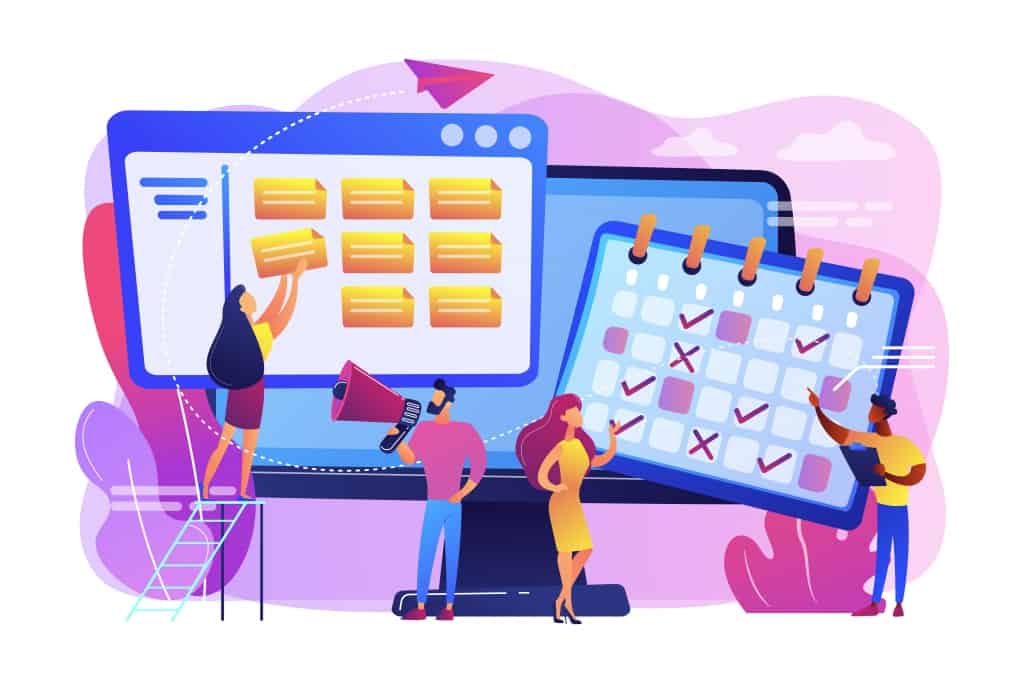Are you ready to become an event organization pro? Look no further than the event planning checklist — the ultimate tool for every event planner.
In this blog post, we'll discover a step-by-step guide to creating an event planning checklist with examples. From staying on top of important tasks to ensuring everything runs smoothly, find out how a well-designed checklist can be your secret weapon for hosting successful events.
Let's get started!
Table of Contents
- Overview
- What Is An Event Planning Checklist?
- Step-by-step Guide To Create Event Planning Checklist
- Examples Of An Event Planning Checklist
- Key Takeaways
- FAQs
Overview
| What does “checklist” mean? | A checklist is a list of tasks or things that you need to check and complete. |
| Benefits of checklists | Easy to follow, saving time and memorizing effort, improving productivity, get more endorphins whenever completing any tasks. |
What Is An Event Planning Checklist?
Imagine you're going to throw a fantastic event, like a birthday party or a company gathering. You want everything to go smoothly and be a huge success, right? An event planning checklist can help with that.
Think of it as a to-do list specifically designed for event planners. It covers various aspects of event organization, such as venue selection, guest list management, budgeting, logistics, decorations, catering, entertainment, and more. The checklist acts as a roadmap, providing a step-by-step framework to follow from start to finish.
Having an event planning checklist is beneficial for several reasons.
- It allows you to track progress, mark completed tasks, and easily see what still needs to be done.
- It helps you can cover all the bases and create a well-rounded event experience.
- It allows you to set realistic deadlines and allocate time for each task.
- It promotes effective collaboration and coordination among the event planning team.

Tips for Better Engagement

Looking for an interactive way to heat up your event parties?
Get free templates and quizzes to play for your next gatherings. Sign up for free and take what you want from AhaSlides!
🚀 Grab Free Account
Step-by-step Guide To Create Event Planning Checklist
Making an event planning checklist does not have to be complicated. You may create a comprehensive and successful checklist for your specific event by following a step-by-step guide:
Step 1: Define the Event Scope and Goals
Start by understanding the purpose and objectives of your event. Determine the type of event you're planning, whether it's a conference, wedding, or corporate party. Clarify the event goals, target audience, and any specific requirements. This information will help you tailor the checklist and event planning tasks accordingly.
You can use some questions as follows to define:
- What is the purpose of your event?
- What are your event goals?
- Who is your target audience?
- Are there any specific requirements you need to meet?
Step 2: Identify Key Planning Categories
Next, break down the planning process into logical categories. Consider aspects such as venue, budget, guest management, logistics, marketing, decorations, food and beverage, entertainment, and any other relevant areas. These categories will serve as the major sections of your checklist.
Step 3: Brainstorm and List Essential Tasks
Within each planning category, brainstorm and list down all the essential tasks that need to be completed.
- For example, under the venue category, you might include tasks like researching venues, contacting vendors, and securing contracts.
Be specific and don't leave anything out. What are the key tasks you need to accomplish for each category?
Step 4: Organize Tasks Chronologically
Once you have a comprehensive list of tasks, arrange them in a logical and chronological order.
Start with tasks that need to be done early in the planning process, such as setting the event date, securing the venue, and creating a budget. Then, move towards tasks that can be completed closer to the event date, such as sending invitations and finalizing the event program.

Step 5: Assign Responsibilities and Deadlines
Assign responsibilities for each task to individuals or team members involved in the event planning process.
- Clearly define who is accountable for completing each task.
- Set realistic deadlines for each task, considering dependencies and the overall timeline of the event.
- How will you distribute the tasks among your team?
This activity ensures that tasks are distributed among the team and that progress is monitored effectively.
Step 6: Take A Step Back and Review Your Checklist
When organizing an event checklist, you should make sure it covers all the necessary tasks and is well-structured. Consider seeking input from other event planning professionals or colleagues to gather valuable insights and suggestions. Refine the checklist based on feedback and your specific event requirements.
Step 7: Add Additional Details and Notes
Enhance your checklist with additional details and notes. Include contact information for vendors, important reminders, and any specific instructions or guidelines that need to be followed. What extra information will be helpful for smooth task execution?
Step 8: Update and Modify as Needed
Remember, your checklist is not set in stone. It's a dynamic document that can be updated and modified as needed. Update it whenever new tasks arise or when adjustments need to be made. Regularly review and revise the checklist to reflect any changes.

Examples Of An Event Planning Checklist
1/ An event planning checklist by category
Here is an example of an event planning checklist by category:
Event Planning Checklist:
A. Define Event Scope and Goals
- Determine event type, goals, target audience, and specific requirements.
B. Venue
- Research and select potential venues.
- Visit venues and compare options.
- Finalize the venue and sign the contract.
C. Budget
- Determine the overall budget for the event.
- Allocate funds for different categories (venue, catering, decorations, etc.).
- Track expenses and adjust the budget as needed.
D. Guest Management
- Create a guest list and manage RSVPs.
- Send out invitations.
- Follow up with guests to confirm attendance.
- Organize seating arrangements and name tags
E. Logistics
- Arrange transportation for guests, if necessary.
- Coordinate audiovisual equipment and technical support.
- Plan for event setup and breakdown.
D. Marketing and Promotion
- Develop a marketing plan and timeline.
- Create promotional materials (flyers, social media posts, etc.).
E. Decorations
- Decide on the event theme and desired ambiance.
- Source and order decorations, such as flowers, centerpieces, and signage.
- Arrange for event signage and banners.
F. Food and Beverage
- Select a catering service or plan the menu.
- Accommodate dietary restrictions or special requests.
G. Entertainment and Program
- Determine the event program and schedule.
- Hire entertainment, such as a band, DJ, or speakers.
- Plan and rehearse any presentations or speeches.
H. On-site Coordination
- Create a detailed schedule for the event day.
- Communicate the schedule and expectations with the event team.
- Assign specific responsibilities to team members for setup, registration, and other on-site tasks.
I. Follow-up and Evaluation
- Send thank-you notes or emails to guests, sponsors, and participants.
- Collect feedback from attendees.
- Review the event's success and areas for improvement.

2/ An event planning checklist by task and timelines
Here's an example of an event planning checklist that includes both tasks and a timeline countdown, formatted as a spreadsheet:
| Timeline | Tasks |
| 8 - 12 Months | - Define event goals, objectives, and target audience. |
| Before the Event | - Determine event date and time. |
| - Create a preliminary budget. | |
| - Research and select a venue. | |
| - Start building a team or hire an event planner. | |
| - Begin initial discussions with vendors and suppliers. | |
| 6 - 8 Months | - Finalize venue selection and sign the contract. |
| Before the Event | - Develop the event theme and concept. |
| - Create a detailed event plan and timeline. | |
| - Start marketing and promoting the event. | |
| 2 - 4 Months | - Finalize event schedule and program. |
| Before the Event | - Coordinate with vendors on specific requirements. |
| - Arrange for necessary permits or licenses. | |
| - Plan event logistics, including setup and breakdown. | |
| 1 Month | - Finalize attendee list and seating arrangements. |
| Before the Event | - Confirm details with entertainment or speakers. |
| - Create a detailed on-site event plan and delegate responsibilities. | |
| - Conduct a final walk-through of the event venue. | |
| 1 Week | - Confirm all details with vendors and suppliers. |
| Before the Event | - Conduct a final headcount and share it with the venue and caterers. |
| - Prepare event materials, name tags, and registration materials. | |
| - Double-check audiovisual equipment and technology requirements. | |
| - Set up an emergency and contingency plan. | |
| Day of the Event | - Arrive early at the venue to oversee setup. |
| - Ensure all vendors and suppliers are on schedule. | |
| - Greet and register attendees upon arrival. | |
| - Oversee the event flow, and manage any last-minute changes or issues. | |
| - Wrap up the event, thank attendees, and collect feedback. | |
| Post-Event | - Send thank-you notes or emails to attendees and sponsors. |
| - Collect event feedback from attendees and stakeholders. | |
| - Conduct a post-event evaluation and debriefing. | |
| - Finalize event finances and settle outstanding payments. | |
| - Review the event's success and areas for improvement. |
Remember to customize your event planning checklist based on your specific event needs and adjust the timeline as required.
Key Takeaways
With the help of an event planning checklist, event planners can stay on top of their tasks, track progress, and avoid overlooking important details. An event checklist serves as a roadmap, guiding planners through each stage of the event planning process and helping them stay organized, efficient, and focused.
Additionally, AhaSlides offers interactive features for audience engagement, such as live polling, Q&A sessions, and interactive presentation templates. These features can further elevate the event experience, foster attendee participation, and gather valuable insights and feedback.
Frequently Asked Questions
What is a checklist for event planning?
It is a comprehensive guide that covers all aspects of event organization, such as venue selection, guest management, budgeting, logistics, decorations, etc. This checklist acts as a roadmap, providing a step-by-step framework from start to finish.
What are the eight steps to plan an event?
Step 1: Define Event Scope and Goals | Step 2: Identify Key Planning Categories | Step 3: Brainstorm and List Essential Tasks | Step 4: Organize Tasks Chronologically | Step 5: Assign Responsibilities and Deadlines | Step 6: Review and Refine | Step 7: Add Additional Details and Notes | Step 8: Update and Modify as Needed
What are the seven key elements of an event?
(1) Objective: The purpose or goal of the event. (2) Theme: The overall tone, atmosphere, and style of the event. (3) Venue: The physical location where the event takes place. (4) Program: The schedule and flow of activities during the event. (5) Audience: The individuals or groups attending the event. (6) Logistics: The practical aspects of the event, such as transportation and accommodations. and (7) Promotion: Spreading awareness and generating interest in the event.
Ref: Georgia Institute of Technology








